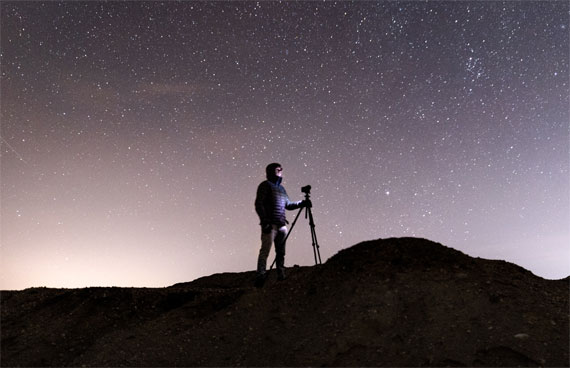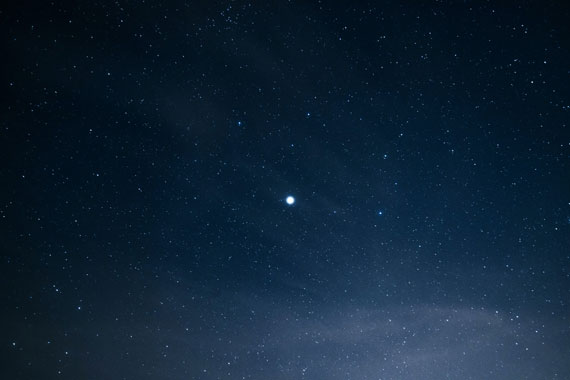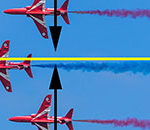Knowing how to take a good picture of the stars is not as complicated as it may seem. Now, there are things that would obviously make it easier to take the pictures, for instance having a telephoto or zoom lens would be very beneficial. But in the following steps you will learn the basics for photographing the night sky.

Photo by Vincent Ledvina
There are 4 steps that you should take for star photography:
- Mount your camera and set your ISO.
- Turn off Auto Focus.
- Set your shutter speed.
- Position yourself and your camera.
Mount Your Camera and Set Your Speed
It is absolutely necessary to use a tripod for nighttime photography because of the long exposure times that are required. Tripods give you the stability required for a clear and crisp picture. You will want to set your camera’s ISO between 200 and 800. This again allows for the cleanest and most crisp photograph you can get. It is also on this step that if you have a telescope or telephoto lens you should connect it.
Turn Off Auto Focus
The reason you turn off auto focus is that your camera may find it difficult to focus on anything in the night sky. So, instead of confusing your equipment, it’s better to just focus in on the sky yourself. I know this may seem odd but if you want to know how to take a good picture of the stars, then trust me—this will work.
Set Your Shutter Speed
You want to set your shutter speed to keep the lens open for as long as possible. The reason we do this is to allow as much light in as possible. Cameras differ on the length of time they allow. The times ranges anywhere between 2 and 40 seconds.

Photo captured by Sven Scheuermeier
Position Yourself and Your Camera
The last step in learning how to take a good picture of the stars is to position yourself in a prime location for a beautiful shot. You want to find a place clear of light pollution and also an area that gives you a clear view of the entire sky. Then find your beauty shot and aim the camera. It’s a good idea to use a timer for the shot or a cable release to avoid vibration with the shot. It’s also a great idea to take more than one shot. Take multiple pictures to guarantee a great photo.
When learning how to take a good picture of the stars, it’s important follow at least these above steps. However, the best advice I could give would be to take a course on the fundamentals of photography. These types of courses cover everything from exposure, aperture, and even composition and color.
About the Author:
Article written by Damian Ray, AbstractDigitalPhotography.
Like This Article?
Don't Miss The Next One!
Join over 100,000 photographers of all experience levels who receive our free photography tips and articles to stay current:






There is a pretty simple calculation available, when you don’t want to have Startrails on you images: Divide 600 by the focal length of your lens (e.g. with a 20mm lens this would be 600/20=30) to get the longest time you can expose without getting startrails (if you use a fixed tripod).
I also don’t agree with the iso thing: I often go as high as 6400, this depends on the camera and needs to be tested.
The described method works best with wide angle lenses and relatively short exposure times (30 seconds or less), but for larger focal lengths or longer exposure times, there are other facts that the photographer must consider. The most important fact is the apparent movement of the sky due to the Earth’s rotation. If the photographer uses a standard field tripod (also known as alt-azimuth tripod) and sets the camera with long exposure times (say, 5 minutes or more), the result will be an image of star trails, where the stars will show as short lines instead of points of light. Of course, star trails are interesting to see, but there are situations where they are not wanted and the Earth’s rotation could be a problem. For example, if the photographer wants to get images of faint deep sky objects like nebula or galaxies, which might require exposure times of several minutes, then those standard field tripods are no longer useful. Instead, the photographer needs to mount the photo equipment on a different kind of tripod that compensates the Earth’s rotation, assuring that the sky objects maintain their position in the field of view. The mount that does this is known as equatorial mount, which can be powered with a motor drive that moves one axis at the same angular speed of the Earth’s rotation. A good understanding of celestial coordinate systems will help a lot to achieve the best results.
Good luck and clear skies!